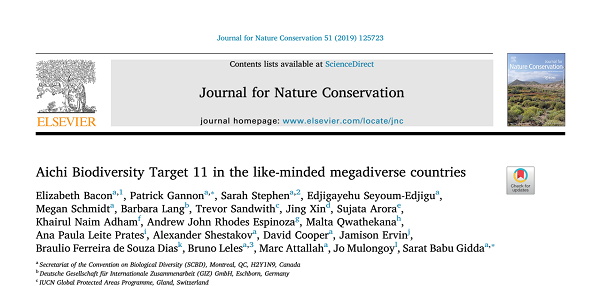First published on 07/20/2019, and last updated on 09/26/2019
Aichi Biodiversity Target 11 in the like-minded megadiverse countries, by Elizabeth Bacona, Patrick Gannona, Sarah Stephena, Edjigayehu Seyoum-Edjigua, Megan Schmidta, Barbara Langb, Trevor Sandwithc, Jing Xind, Sujata Arorae, Khairul Naim Adhamf, Andrew John Rhodes Espinozag, Malta Qwathekanah, Ana Paula Leite Pratesi, Alexander Shestakova, David Coopera, Jamison Ervinj, Braulio Ferreira de Souza Diask, Bruno Lelesa, Marc Attallaha, Jo Mulongoyl, Sarat Babu Giddaa, Journal for Nature Conservation Volume 51, 12 pages, October 2019.
Abstract
“The group of like-minded megadiverse countries (LMMCs), which harbours a wealth of biological and cultural diversity, adopted a Carta in 2016 to accelerate progress towards achieving Aichi Biodiversity Target 11. This paper presents the progress made over the last two years and an analysis of the LMMCs’ national priority actions; approved Global Environment Facility, GEF-5 and GEF-6 protected area-related biodiversity projects; and relevant targets, goals, and actions from National Biodiversity Strategies and Action Plans (NBSAPs).
Through their recent actions, these countries have contributed to progress in Target 11, especially with respect to marine protected area expansion, where they contributed one-sixth of the area added in national waters over the past two years.
Results indicate that if implemented as planned, actions proposed by the LMMCs will increase terrestrial and marine protected area coverage by 1,106,148 km2 and 192,214 km2 respectively. Of these commitments, 227,230 km2 in terrestrial and 144,475 km2 in marine protected areas have the highest chance of being implemented.
In total, 741 commitments were identified from the above sources, with implications on the qualitative elements of Target 11 (coverage of areas important for biodiversity, areas important for ecosystem services, ecological representation, connectivity, effective management, equitable management, and integration into the wider landscapes and seascapes). Of these 741 commitments, 25% showed a strong likelihood of being implemented. The country-level analysis of all commitments indicates that equitable management and integration will show the most progress, measured against identified gaps, if commitments are implemented as proposed. This progress on the qualitative elements of Target 11 in the LMMCs will also provide benefits and cobenefits for other Aichi Targets and for the requirements of other multi-lateral environmental agreements, as well as at the global level.”
An extract about how ICCAs contribute to reaching Aichi Target 11
” The integration of indigenous lands into protected and conserved areas frameworks, may offer an important opportunity to increase recognition and support for ICCAs (Jonas et al., 2017), however the scaleup of incorporation of OECMs and ICCAs into national reporting on progress towards Target 11 warrants the employment of necessary safeguards relating to the rights of IPLCs. OECMs may be a more appropriate designation to recognise the conservation being carried out by IPLCs, however indigenous lands should not be considered de facto protected areas or OECMs. With the potential of indigenous lands to complement and enhance existing protected and conserved area networks and strategies (Garnett et al., 2018), full participation of IPLCs must be ensured. There must be free, prior, and informed consent, including for the establishment, governance, planning, monitoring and reporting of protected and conserved areas on IPLCs’ traditional territories (lands and waters); appropriate recognition afforded to collective rights, especially pertaining to land tenure; respect for their self-determination, local and cultural institutions, and traditional knowledge; and support to their efforts to develop and maintain sustainable livelihoods. Respect and recognition of IPLC lands and waters within existing protected areas is also required (Stevens et al., 2016). Some of these safeguards are reflected in the criteria for identification of OECMs (CBD, 2018a). “
